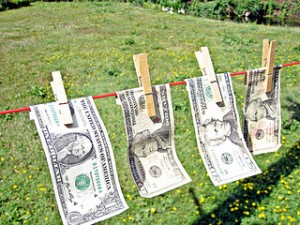 Last week I was watching an old episode of Law & Order surrounding a criminal organization and how they were laundering money through different businesses in New York. The term money laundering is thrown around in the media quite often, however, many of us are probably wondering, “what is money laundering?”
Last week I was watching an old episode of Law & Order surrounding a criminal organization and how they were laundering money through different businesses in New York. The term money laundering is thrown around in the media quite often, however, many of us are probably wondering, “what is money laundering?”
If you were to look at the money laundering definition on Wikipedia you would find the following:
Money laundering is the process of concealing sources of money. Money evidently gained through crime is “dirty” money, and money that has been “laundered” to appear as if it came from a legitimate source is “clean” money. Money can be laundered by many methods, which vary in complexity and sophistication.
Essentially money laundering is turning “dirty money” into “clean money” with the use of legitimate means. There are several different ways to launder money, but these are some of the most common.
Money Laundering Techniques
Use of a legitimate business
One of the most common examples of laundering money include the use of a legitimate businesses. A crime organization will set up a business that takes in a lot of cash during the day. This could be a dry cleaner, strip clubs or even a casino. At the end of each day, they will create fake business invoices which make it look like the money had actually been earned by services completed. As long as these individuals are paying their taxes, they typically won’t draw any red flags from Uncle Sam.
For those of you who were a fan of The Sopranos, think Bada Bing! This was the strip club that Tony Soprano and his crew ran.
Cashing out at a casino
The casino is not only a hot spot for the compulsive gambler. It’s also a favorite for a money launderer. An individual will head into a casino and use the dirty money to buy casino chips. He will then play for awhile and cash out. While he might have come with dirty money, it now just looks like he cashed out big.
Using investments to move money
The first job I found out of college was working on the trade desk of a commodities brokerage firm. They regularly made all employees go through anti-money laundering classes. These helped us spot anyone attempting to launder money through commodity trades.
What an individual can do is deposit the dirty money into a trading account and use it to make investment trades. Once he cashes the money out, it would appear to be clean and look like trading profits. This form of money laundering is pretty infrequent now because banks have such tight security.
Notable Money Laundering Cases
HSBC
In 2013, HSBC was required to pay $1.92 Billion in fines for their role in a money laundering scheme. The bank was transferring billions of dollars for Mexican drug cartels and for nations that are currently under United States Sanctions. They were also working closely with a bank in Saudi Arabia that is known to have ties to terrorist organizations.
Liberty Reserve
Liberty Reserve was one of the most well known payment processors in Costa Rica. In May 2013 it was seized by the United States for laundering $6 Billion.
Standard Charter
In 2012 the British bank, Standard Charter, agreed to pay the United States $330 Million in order to settle claims that it laundered totals well into the hundreds of billions of dollars for Iran.
Final thought
Money laundering is a serious crime that comes with large fines and some major prison time. If you leave a comment telling me a better way (a way you have used) to launder money assume that I will probably report you to the police.
